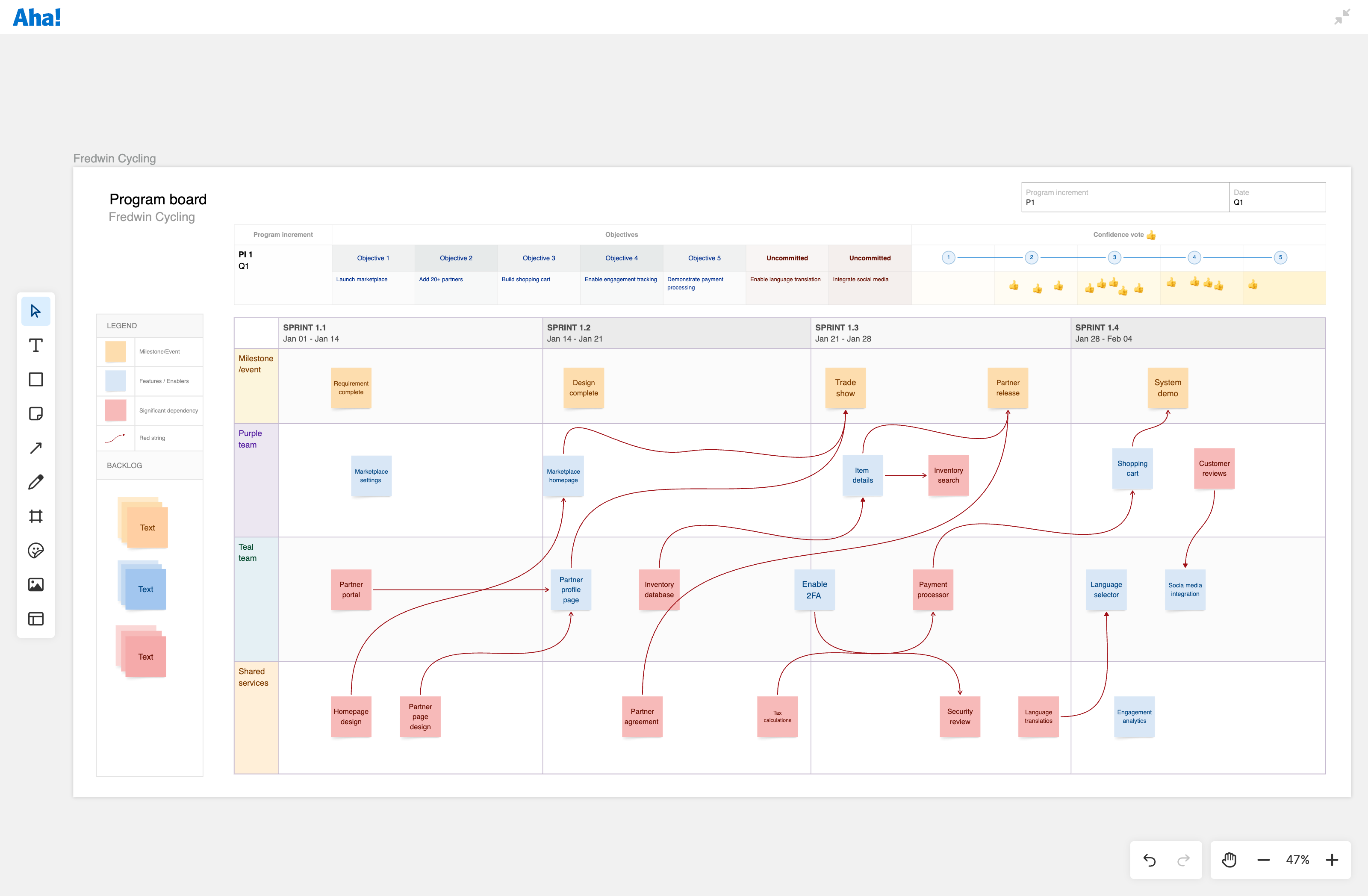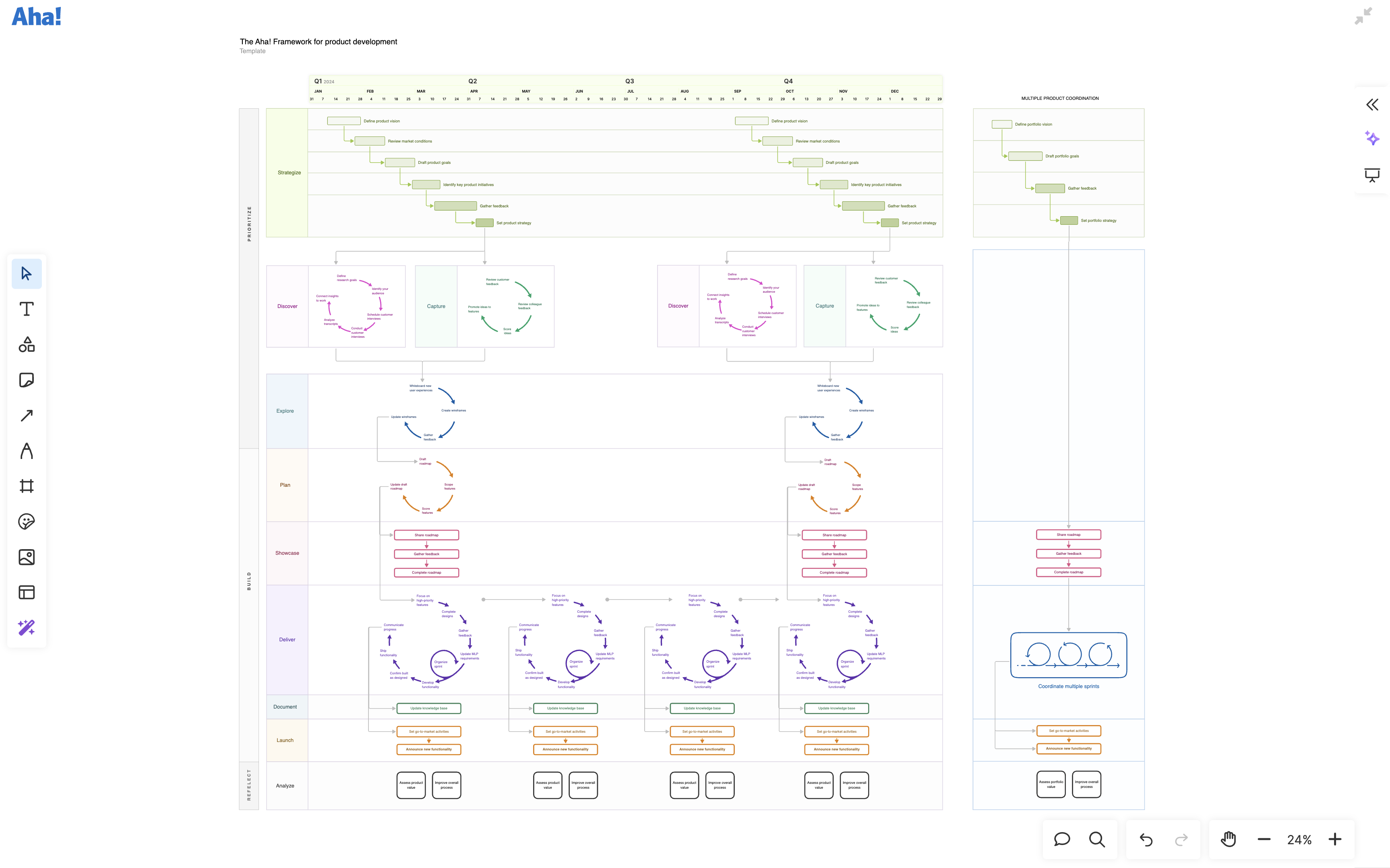SAFe® planning and implementation
Planning and implementation are central to SAFe's success. After selecting the right configuration, the focus shifts to how work is planned, executed, and tracked across teams and organizational levels. At the core of this are two key elements: PI planning, which aligns ART teams around shared objectives, and the spanning palette, which provides tools and practices that promote alignment and visibility at every level. Together, these elements create a structured, yet adaptable framework for delivering value.
PI planning
PI planning is a key SAFe practice that brings together ART teams to align on priorities and commit to a shared plan for the next increment. This collaborative event typically occurs every eight to 12 weeks, aligning with quarterly business cycles.
PI planning provides a structured way to translate high-level goals into actionable work for teams. Key stakeholders — including development, product management, and leaders — align on the increment's business vision, technical priorities, and objectives.
Here is how PI planning typically unfolds:
Define and prioritize work: Product management presents features and priorities for the increment.
Break down work: Development teams decompose features into user stories, estimate capacity, and identify risks and dependencies.
Resolve risks: Release train engineers (RTEs) and scrum masters collaborate to address identified risks and ensure dependencies are managed.
Review and adjust: Leadership reviews the proposed plan, making adjustments to scope or objectives as needed.
Commit to the plan: Teams vote on the finalized plan to discern shared confidence and alignment.
Once the plan is set, teams execute it using agile practices, including iteration planning, delivering to acceptance criteria, and continuously improving through demos and retrospectives. ART-wide synchronization enhances predictability and agility, while release timing remains flexible (whether based on PI completion, continuous delivery, or another cadence suited to business needs).
PI planning is foundational in SAFe and adapts to the scale of each configuration:
Essential ART: Focuses on aligning teams within a single ART around shared objectives
Large Solution: Expands coordination to multiple ARTs supported by solution train engineers to manage dependencies across teams
Portfolio: Connects ART-level planning to portfolio objectives, creating alignment with strategic goals
Full SAFe: Orchestrates planning and alignment across solution trains, ARTs, and portfolios to establish enterprisewide coordination
Related:
SAFe® spanning palette
The spanning palette provides roles, artifacts, and practices that apply across all SAFe configurations, from individual teams to large portfolios. It acts as a unifying framework — ensuring all levels of the organization stay aligned and focused on delivering value.
In Essential SAFe, the spanning palette includes foundational elements that guide and support PI planning and execution:
Vision: Defines the broader business objectives and provides context for each PI, helping teams stay aligned and motivated
Roadmap: Offers a high-level plan across multiple PIs, enabling long-term planning and coordination with strategic goals
Backlogs: Translate roadmap objectives into actionable work, making sure prioritized features and tasks flow seamlessly into PI planning
In Large Solution SAFe and Full SAFe, the spanning palette expands to support coordination across multiple ARTs and solution trains. These elements ensure that work remains visible and aligned at every organizational level, even in highly complex systems.
By combining vision, roadmap, and backlog, the spanning palette helps teams balance strategic alignment with agile execution. It allows teams to stay focused on long-term objectives while adapting to change, making it a critical tool for scaling agile effectively.
Top
How does SAFe® compare to other agile frameworks?
SAFe is a popular framework for scaling agile across large organizations, but it is not the right fit for everyone. Some teams find it too complex or resource-intensive to implement effectively. As a result, many organizations explore alternative frameworks to scale agile while tailoring practices to their specific needs.
The best framework for your organization depends on your goals, team structure, and desired level of flexibility — whether you aim to improve workflow efficiency or align strategy with execution.
Below, we compare several frameworks at scale, including SAFe, scrum, kanban, and The Aha! Framework for product development. This comparison highlights the primary focus, practices, and suitability of each approach for large organizations.
Framework | Primary focus | Core practices | Team size and structure | A good fit for |
SAFe | Scaling agile across large teams, aligning development with business strategy, and managing dependencies | Agile release trains (ARTs), PIs, lean portfolio management | Large-scale cross-functional teams (50-150+ people) | Large organizations managing complex products and systems, or portfolios requiring strategic alignment |
Scaled kanban | Optimizing workflow efficiency and visibility across multiple teams or departments | Continuous flow, work-in-progress (WIP) limits, advanced analytics, and visual boards | Flexible; suitable for teams or enterprise-level adoption | Organizations prioritizing operational efficiency and flexibility without a rigid structure |
Scrum@Scale | Scaling scrum practices to coordinate multiple teams and deliver iterative value | Time-boxed sprints, scaled ceremonies, scrum of scrums coordination | Multiple scrum teams working in synchronized iterations | Companies focused on iterative delivery, team collaboration, and frequent customer feedback |
The Aha! Framework | Integrating strategy and execution with a simple, efficient approach to agile work | Biannual strategic alignment, one- to two-week sprints, continuous delivery | Suitable for small teams or large cross-functional organizations | Product-driven organizations seeking strategic alignment without unnecessary complexity |
You might have noticed The Aha! Framework included in the table above. As a newer approach, it is likely less familiar than frameworks like SAFe or Scrum@Scale. The Aha! Framework for product development is designed to meet the needs of enterprise organizations managing multiple portfolios, but it takes a simpler, more intuitive approach.
Unlike SAFe, it aligns with the natural stages of product development — avoiding complex terminology and costly certifications that can create barriers to adoption. Its flexibility allows product teams to incorporate its practices into existing workflows and meetings with minimal disruption.
For large organizations seeking to scale agile practices efficiently (without the added complexity of traditional frameworks), The Aha! Framework offers a streamlined and accessible alternative.
The Aha! Framework for product development is a repeatable process for building lovable products. Learn more.




